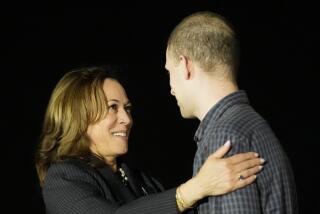Hostage Ordeal Ends as Anderson Is Freed : Mideast: ‘Faith, stubbornness’ kept him going through 6 1/2 years as captive, American says. He left his captors with a single word--’Goodby.’
DAMASCUS, Syria — Terry A. Anderson, the last American hostage in Lebanon, finally became a free man again Wednesday, closing the door on a dark and painful chapter for himself and his country.
Held for more than 6 1/2 years in captivity, deprived of family and friends, denied all but the simplest necessities, an innocent victim of the hatreds of the Middle East, Anderson said he left his militant captors in Beirut with a single word: “Goodby.”
The nearly decade-long drama of the hostages came to a joyous finish at a late-night press conference in the Syrian Foreign Ministry here.
Anderson, the 44-year-old chief Middle East correspondent for the Associated Press, hailed old colleagues, embraced an AP correspondent and thanked the governments and organizations and “thousands and thousands of people whom I don’t know, I’ve never met, don’t know me, who I know have been working and praying for us all, all the hostages.
“Your support, your prayers were important. They made a big difference, they made a difference for us in some very dark times. My family, of course, my incredible sister, Peg, I will be thanking shortly myself and personally.”
Anderson greeted his assembled colleagues, saying simply, “You can’t imagine how glad I am to see you.”
Wearing broken eyeglasses, a cardigan sweater and an open-neck white shirt--and looking well with his mustache neatly trimmed--Anderson seemed to emerge from captivity in better shape than any of the recently released hostages.
Asked what kept him going through the hard years, the one-time Marine sergeant replied: “My companions . . . my faith, stubbornness I guess. You just do what you have to do.” And commenting on his title as the longest-held hostage: “It’s an honor I’d have gladly given up a long time ago.”
Early today, Anderson arrived at a U.S. military base in Frankfurt, Germany, on the first leg of his long journey home after 2,454 days of captivity.
Accompanied by his fiance, Madeleine Bassil, and his 6-year-old daughter, Sulome--a child he had only seen blowing him kisses in birthday videotapes until Wednesday--Anderson bounced off an Air Force plane that had carried him from Damascus and waved to a cluster of well-wishers.
Anderson waved an American flag to a cheering group of about 75 to 100 service personnel and their families who had gathered on the edge of the tarmac, braving a late-autumn drizzle to greet the newly freed hostage. The well-wishers waved small paper American flags, cheered and held up a banner with the words, “Welcome Back Terry Anderson.”
He was welcomed as he got off the plane by the U.S. ambassador to Germany, Robert Kimmitt. As Anderson went down a small receiving line of dignitaries at planeside, he held his daughter’s hand tightly.
Then he was taken by a waiting helicopter to a military hospital at nearby Wiesbaden for medical examinations and debriefing by a State Department team. In Wiesbaden, he was reunited with his sister, Peggy Say, who spent Anderson’s years in captivity campaigning for his freedom.
“It’s great to have a sister like that,” he said. “You get yourself in trouble, and she comes along to get you out.”
At the hospital, he posed with fellow ex-hostages Alann Steen and Joseph C. Cicippio.
At least 87 foreigners were kidnaped in Lebanon during the ugly era that gave the word hostage a wrenching, personal meaning to Americans.
Seventeen U.S. citizens were among them; three were slain in captivity.
Anderson was held longer than any foreign hostage and is the latest in a series to win freedom over the past five months, three in the past three days, under a breakthrough initiative launched by U.N. Secretary General Javier Perez de Cuellar.
Two German aid workers are still held.
But it was Anderson who represented the defiant spirit and terrible plight of the hostages, and while he was caged in the name of Islamic militancy, his name became known across his country and the globe.
Even at the end of his ordeal, freedom seemed hard to grasp.
Informed Tuesday that he would be released, Anderson said he spent a fitful night that led to a frustrating day, as his journey to Damascus was delayed and forced to detour by snow-blocked roads. The usual three-hour trip from Beirut--where he was turned over to Syrian military authorities--to Damascus took 12 hours, with several stops.
“I spent the afternoon, interestingly enough, playing solitaire by candlelight and listening to the BBC reporting on my progress,” Anderson said. “It was kind of fun in a weird kind of way; it was kind of like listening to your own obituary.
“I think these last 24 hours have been longer than the whole 6 1/2 years.”
From the White House, President Bush called Anderson in Damascus “to express the love and admiration that all Americans have for Terry,” White House spokesman Marlin Fitzwater said.
Before he was released, Anderson read a videotaped message from the Islamic Jihad kidnapers’ group that held him, a message that preceded the journalist to Damascus.
The statement was handed to an AP reporter at midday by two bearded men. It made clear that the end of the hostage drama will not exhaust the militancy of Lebanon’s Shiite Muslims and others in the troubled region.
“Although we are closing the file of the captives,” the statement declared, “this doesn’t mean the confrontation with the Americans and Israelis is halted. The captivity of some persons is only one of the styles to confront and action whose causes still exist and thus the war is going on.”
Anderson said he made clear that it was the kidnapers’ statement, not his, “but I thought it was worthwhile to listen to what they had to say.”
The good news for the hostage in the statement was brief but meaningful: “We’re going to free our last captive, Terry Anderson, thus folding this page in the hostage file before glorious Christmas.”
Anderson was a captive of his militant Shiite kidnapers for 6 years, eight months and 18 days. Like most of the hostages, he was detained in dark, cell-like rooms, blindfolded night and day, chained to walls and radiators. Many of the hostages who have been freed have reported that they were tortured routinely.
British cameraman John McCarthy and American professor Thomas M. Sutherland, who were held with him, said that Anderson inspired and goaded them to keep going.
In Damascus to meet Anderson on Wednesday were his daughter and her mother.
Sulome, a bright 6-year-old with curly red hair, was born in the United States three months after the journalist was kidnaped. Carrying a school bag on her back and bundled in a purple sweater and leggings against the onset of winter cold, she arrived Monday on a flight from Cyprus, where Bassil has been living.
(In Tokyo, Anderson’s estranged wife, Mihoko, and daughter, Gabrielle, now 15, declined to comment on Wednesday’s release.)
In his long captivity, Anderson had treasured a photo of Sulome that his kidnapers allowed him to receive. In a videotape, shot by a Lebanese company and aired over Cable News Network two months ago, the captive journalist said he had also heard a British Broadcasting Corp. radio message from Sulome. “I was delighted,” he said.
The conditions of the October interview were not clear, but Anderson used it to praise Perez de Cuellar’s efforts and those of others who have kept the hostage issue alive through the long years, mentioning specifically his sister. She had tirelessly carried on a campaign for his release through the media and in visits to Damascus and other Middle East capitals.
“We are grateful to all of you,” he said at the time, and added: “I can say I think it is an absolute necessity that everyone involved in this process . . . simply cooperate, that this is no longer the time for bargaining, this is no longer the time for anyone to try to get some small advantage out of each step in the process that might be coming to fruit here.”
Since that statement, the U.N. initiative produced results in rapid order:
* On Oct. 19, Israel said it had received proof from the Arab side that one of its missing servicemen was dead. Two days later, 15 Arab prisoners were released from a prison in the Israeli security zone in southern Lebanon.
* On Oct. 22, American hostage Jesse Turner was freed.
* On Nov. 18, Islamic Jihad, the group that held Anderson, released Sutherland and British churchman Terry Waite, who had been kidnaped in January, 1987, on a mission to negotiate freedom for previously abducted hostages.
* This week, Israel released 25 more prisoners Sunday, and American captives Cicippio and Steen were freed Monday and Tuesday. Unconfirmed reports in Beirut and elsewhere said Anderson would be freed Wednesday, as he was.
Anderson went to Beirut in the dangerous days of 1982, the year of the Israeli invasion of Lebanon, after serving with the AP in Tokyo and Johannesburg. Three years later, on March 16, 1985, he was driving back to his office with AP photographer Don Mell after a tennis match when their car was stopped and Anderson was hauled away by gunmen. He appeared to be a deliberate target, since Mell was not taken.
Times staff writers Tyler Marshall and Tammy Jones in Germany contributed to this report.
RELATED STORIES: A6-17
Chronology of Anderson’s Captivity
1985
March 16--Anderson abducted on Beirut street by Islamic Jihad.
May 16--First photo of Anderson in captivity released. Islamic Jihad warns of “catastrophic consequences” if Kuwait does not free terrorists.
June 7--Anderson’s daughter Sulome is born.
1986
Feb. 15--Anderson’s father dies of cancer at age 69.
June 7--Anderson’s 46-year-old brother dies.
Oct. 3--In a videotape, Anderson and hostage David Jacobsen urge President Reagan to work hard for their release.
Nov. 2--Jacobsen, freed after 17 months in captivity, says hostages “are in hell.”
1987
Nov. 26--Jacobsen says he has been told Anderson is being held again in chains and blindfolded 24 hours a day.
1988
April 10--Islamic Jihad threatens to kill the captives if any attempts is made to storm a hijacked Kuwaiti jetliner.
Aug. 18--Photo of Anderson issued with new demands: Israeli withdrawal from south Lebanon and compensation for reconstruction of south Lebanon and south Beirut.
Oct. 23--Islamic Jihad threatens that the hostages will suffer if the group’s demands are not met.
Oct. 31--In a videotape, Anderson says: “I find it difficult to keep my hope and courage high.”
1989
Oct. 24--Islamic Jihad again demands the release of Shiite comrades jailed in Kuwait.
1990
Feb. 9--Anderson’s sister, Peggy Say, begins a new international tour to enlist support in winning her brother’s freedom.
May 7--Say is told by newly freed hostage Frank Reed that her brother was in good health during the time they were held together but that he had not seen him since 1989.
Sept. 5--Anderson’s 2,000th day in captivity.
1991
March 13--In the wake of Iraq’s defeat in the Gulf War, U.S. Secretary of State James A. Baker III visits Syria to discuss the hostages. Syria reiterates that it will work for their release.
Oct. 6--In a videotape, Anderson urges all parties to accelerate negotiations to free Western hostages and says hundreds of Arab prisoners deserve freedom too.
Oct. 27--Anderson’s 44th birthday, his seventh in captivity.
Dec. 4--Anderson is released in Lebanon.
More to Read
Sign up for Essential California
The most important California stories and recommendations in your inbox every morning.
You may occasionally receive promotional content from the Los Angeles Times.










